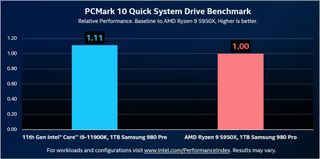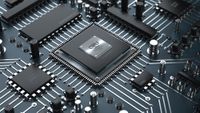Intel: Rocket Lake's PCIe 4.0 Storage Performance is 11% Faster Than AMD Ryzen
The storage wars ignite


Intel's Rocket Lake is on the launchpad for release this quarter, and in traditional fashion, the company began teasing hard gaming performance numbers during CES 2021. Now, Ryan Shrout, Intel's Chief Performance Strategist, has teased a new benchmark result via Twitter that shows the flagship Rocket Lake Core i9-11900K beating AMD's fastest mainstream chip, the Ryzen 9 5950X, by 11% in a storage benchmark conducted by Allyn Malventano, a Storage Technical Analyst with Intel. The company says the faster performance comes courtesy of the PCIe 4.0 interface on its 500-series motherboards for Rocket Lake.
Intel is a bit more than fashionably late to adopting PCIe 4.0, AMD embraced the speedier interface two years ago, but Intel is finally making the move with Rocket Lake. Intel's test results slide notes that 'results may vary,' and as with all vendor-provided benchmarks, you should take the results with the requisite grain of salt.
At #CES21 we looked at Rocket Lake-S gaming. Here’s a sneak peek of Core i9-11900K PCIe Gen 4 storage performance - up to 11% faster on PCMark 10 Quick System Drive Benchmark vs the 5950X. Thanks @Malventano for the data. Backup: https://t.co/LcI5n5Cok2 pic.twitter.com/NhblHRQJSCFebruary 23, 2021
Intel ran PCMark 10's Quick Storage Benchmark test for its comparison, which is one of four possible benchmarks in the popular test suite. PCMark 10's documentation points out that this "is a shorter test with a smaller set of less demanding real-world traces" that's used to test smaller system drives that cannot run the Full System Drive benchmark that we use in our SSD reviews. This test performs mundane tasks like small file transfers/copies and runs Microsoft Excel, Adobe Illustrator, and Photoshop traces that emulate real-world performance.
As noted, the other PCMark 10 storage tests are much more demanding. However, the extended benchmarks push the bottleneck back to the storage device, largely removing the CPU/interface from the equation because the tests access a very large portion of the drive (100GB+ span) to push the drive into a degraded state. This is the long way of saying that it makes sense to use the shorter benchmark in an attempt to isolate either the CPU or the PCIe 4.0 interface as the bottleneck.
Intel outfitted both test systems (500-series motherboards for both chips) with a drive for the operating system and a secondary PCIe 4.0 1TB Samsung 980 Pro (50% full) as the test device. Intel connected these drives to a riser card placed in the PCIe slot, which should remove any interference from the platform controller hub (PCH) on the test results. We've included the test notes below.
The results are pretty straightforward - Intel claims that Rocket Lake is 11% faster in this benchmark than the Ryzen 9 5950X, and it's noteworthy that this doesn't boil down to having a 'faster' physical PCIe 4.0 connection than present on AMD's motherboards. Instead, storage performance is impacted by a host of factors, including system drivers, motherboard firmware, and CPU performance. All in all, Intel claims that these factors combined to give Rocket Lake the upper hand in the tests.
Fast storage performance is important, and Intel's late move to the PCIe 4.0 interface is welcome. However, it's noteworthy that even if Intel has taken the lead in storage performance, AMD's modern Ryzen platforms offer up more PCIe 4.0 connectivity: Intel's Z590 chipset features PCIe 3.0 lanes for devices connected to the PCH, while AMD's PCH serves up PCIe 4.0.
Intel has added a single direct PCIe 4.0 x4 interface for connecting M.2 storage devices to Rocket Lake chips, and you'll either have to use this interface or place your SSD in a riser card in the PCIe slot to unlock the best performance possible with Rocket Lake. It's too bad that Intel killed off its Optane drives for desktop PCs, or we might see a more pronounced difference in the benchmark.
Stay on the Cutting Edge
Join the experts who read Tom's Hardware for the inside track on enthusiast PC tech news — and have for over 25 years. We'll send breaking news and in-depth reviews of CPUs, GPUs, AI, maker hardware and more straight to your inbox.
Faster storage performance will benefit users that tend to transfer large files, and also those with more prosumer-class workloads, like heavy video editing, but most gamers wouldn't notice the difference in typical conditions. You can see everything we know about Rocket Lake here, but we'll have to wait for the final silicon to see how the chips stack up in our CPU Benchmarks performance hierarchy.


Paul Alcorn is the Managing Editor: News and Emerging Tech for Tom's Hardware US. He also writes news and reviews on CPUs, storage, and enterprise hardware.
-
MarsISwaiting Intel is trying to make 11% faster storage look like something huge like CPU performance difference... no one would care about 11% better read write, for Such differences matters in servers only , which this CPU is not aimed at to begin with.Reply -
Clear CMOS. Power down the system and take the little battery out for five minutes and put it back in and reboot and see if you can get to the BIOSReply
-
InvalidError For a long time, AMD's chipsets were ~10% worse than Intel's at USB and SATA. As evidenced by AMD's USB drop-out issues, AMD still has some IO quirks to work out and it wouldn't be too surprising if those affected its 4.0 performance.Reply -
MarsISwaiting ReplyInvalidError said:For a long time, AMD's chipsets were ~10% worse than Intel's at USB and SATA. As evidenced by AMD's USB drop-out issues, AMD still has some IO quirks to work out and it wouldn't be too surprising if those affected its 4.0 performance.
NVME Storage on PCIe 4.0 has nothing to do with SATA or USB controllers . not related at all. This is direct CPU lanes , no bridge or chipset in between . -
InvalidError Reply
So what? PCie lanes don't directly connect to CPU cores, they have to go through a routing and arbitration layer that interfaces with the infinity fabric between the IOD, CCD(s) and between cores just like they do between the uplink and downlinks within a chipset. Glitches and excess latency at any stage can cause substantial performance degradation and AMD's Zen 2/3 start with a ~20ns handicap courtesy of its CCD-IOD interface.MarsISwaiting said:NVME Storage on PCIe 4.0 has nothing to do with SATA or USB controllers . not related at all. This is direct CPU lanes , no bridge or chipset in between . -
MarsISwaiting ReplyInvalidError said:So what? PCie lanes don't directly connect to CPU cores, they have to go through a routing and arbitration layer that interfaces with the infinity fabric between the IOD, CCD(s) and between cores just like they do between the uplink and downlinks within a chipset. Glitches and excess latency at any stage can cause substantial performance degradation and AMD's Zen 2/3 start with a ~20ns handicap courtesy of its CCD-IOD interface.
Had it been the case we would have seen 11% GPU decrease in performance as well. -
TheJoker2020 Reply
No. You would have seen a decrease in performance of sending data between main memory and the graphics card, that is not the same as graphics card performance.MarsISwaiting said:Had it been the case we would have seen 11% GPU decrease in performance as well. -
TheJoker2020 I am taking these Intel internal benchmarks with a pinch of salt. Independent testing will either confirm or deny this claim when these CPU's, motherboards and RAM appear on the market.Reply -
Makaveli ReplyTheJoker2020 said:I am taking these Intel internal benchmarks with a pinch of salt. Independent testing will either confirm or deny this claim when these CPU's, motherboards and RAM appear on the market.
Agreed.
Wait until a full review is out.
And that fact that this data is by Ryan shroud who is a major shill I would wait for more information. -
InvalidError Reply
Increased latency and reduced bandwidth don't have anywhere near 1:1 correlation with graphics performance: look at PCIe scaling benchmarks where going from 4.0x8 or 3.0x16 to 4.0x16 only yields a 0-5% difference for 100% more PCIe bandwidth on GPUs with enough VRAM to keep assets on-board.MarsISwaiting said:Had it been the case we would have seen 11% GPU decrease in performance as well.
As joker wrote, latency and bandwidth only affect how fast you can read/write from/to the GPU, not how fast the GPU does whatever it needs to do once tasks get in its job queue. PCIe latency and bandwidth has negligible effect on GPU performance once assets are loaded, which is why mining rigs are managing perfectly fine with PCIe 2.0x1 per card no matter how powerful the card is.
Most Popular

